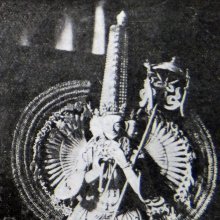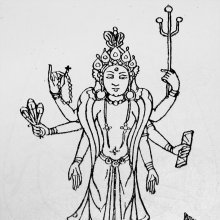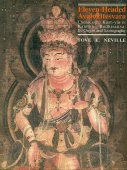Iconography: 4 definitions
Introduction:
Iconography means something in Hinduism, Sanskrit. If you want to know the exact meaning, history, etymology or English translation of this term then check out the descriptions on this page. Add your comment or reference to a book if you want to contribute to this summary article.
Images (photo gallery)
(+359 more images available)
In Hinduism
Shaivism (Shaiva philosophy)
Source: SOAS University of London: Protective Rites in the Netra TantraIconographies are vital to the Tantric rites of the mantramārga.—Within the Bhairava Tantras, deities appear in multiple forms, sometimes manifesting as mantras and at others resembling their Purāṇic forms. The practitioner uses these scriptural depictions of deities to call forth a visualized form that appears on the ritual diagram, the maṇḍala. He then performs sacrificial rites in which he presents the deity ritual offerings and asks for salvation (mokṣa) or worldly enjoyments (bhoga).

Shaiva (शैव, śaiva) or Shaivism (śaivism) represents a tradition of Hinduism worshiping Shiva as the supreme being. Closely related to Shaktism, Shaiva literature includes a range of scriptures, including Tantras, while the root of this tradition may be traced back to the ancient Vedas.
Purana and Itihasa (epic history)
Source: Shodhganga: Elements of Art and Architecture in the Trtiyakhanda of the VisnudharmottarapuranaIconography refers to one of the topics dealt with in the Puranic literature: a category of ancient Sanskrit texts which gives a huge contribution in the development of Indian literature.—The Vishnudharmottara Purana contains different aspects of knowledge. Along with the narratives, this work bears immense information in various fields of study. [...] The third khanda contains 118 chapters which are dedicated to various contents such as Sanskrit and Prakrit Grammar, Lexicology, Metrics, Poetics, Dance, Drama, Music, Painting, Iconography, Architecture etc.

The Purana (पुराण, purāṇas) refers to Sanskrit literature preserving ancient India’s vast cultural history, including historical legends, religious ceremonies, various arts and sciences. The eighteen mahapuranas total over 400,000 shlokas (metrical couplets) and date to at least several centuries BCE.
Shilpashastra (iconography)
Source: Shodhganga: Elements of Art and Architecture in the Trtiyakhanda of the Visnudharmottarapurana (shilpa)Iconography existed in ancient India since ancient Vedic time.—According to the Viṣṇudharmottarapurāṇa, from the kaliyuga, the necessity of temple as well as practice of image worship had started. The development of Iconography had been continuing in the society of India through the pages of epics and Purāṇas. [...] In the Puranic literature, a great discussion on Iconography can be found. The sixteenth Chapter of Agnipurāṇa deals with Iconography. In the Matsyapurāṇa, ten chapters from 258th to 267th are attributed to Iconography. The Viṣṇudharmottarapurāṇa also has offered a great discussion on Iconography. Moreover, Śilpaśāstras viz., the Bṛhatsaṃhitā, Mānasāra, Śilparatna, Devatāmurtiprakaraṇa etc. have the discussion on Iconography. Thus it can be assumed that in later period the practice of image worship came forward and still the practice of image worship is prevailing in Indian society.

Shilpashastra (शिल्पशास्त्र, śilpaśāstra) represents the ancient Indian science (shastra) of creative arts (shilpa) such as sculpture, iconography and painting. Closely related to Vastushastra (architecture), they often share the same literature.
Pancaratra (worship of Nārāyaṇa)
Source: Shodhganga: Kasyapa Samhita—Text on Visha Chikitsa (p)Iconography refers to one of the principal topics of the Pāñcarātra division of the Vaiṣṇava Āgamas.—The almighty Hari, out of compassion for mankind in general, felt that the Vedas and Śāstras could not be easily grasped and practised by people belonging the diverse communities and cadres, whose potential and comprehension would vary vastly. Hence, he promulgated the Pāñcarātra doctrine [teaching for example iconography] which is the essence of the Vedas, in a simplified form.

Pancaratra (पाञ्चरात्र, pāñcarātra) represents a tradition of Hinduism where Narayana is revered and worshipped. Closeley related to Vaishnavism, the Pancaratra literature includes various Agamas and tantras incorporating many Vaishnava philosophies.
See also (Relevant definitions)
Ends with: Hindu iconography.
Full-text (+1744): Agni, Vayu, Aparajitapriccha, Asana, Ketu, Adhikarin, Sthanaka, Acira, Vishvaksenasamhita, Shukra, Anantasana, Sadhanamala, Vastusara, Jambunada, Brahma, Ciṟpa Cennūl, Pratima, Pratimashilpa, Vishnu, Nyagrodha.
Relevant text
Search found 58 books and stories containing Iconography; (plurals include: Iconographies). You can also click to the full overview containing English textual excerpts. Below are direct links for the most relevant articles:
Lakulisha-Pashupata (Philosophy and Practice) (by Geetika Kaw Kher)
Brief History of Saivism with a Focus on Pasupati Aspect < [Chapter 1 - The Historical Context]
Evidence of Ajivika cult in Kashmir < [Chapter 2 - Spread and Transition]
Animal Kingdom (Tiryak) in Epics (by Saranya P.S)
Vishnudharmottara Purana (Art and Architecture) (by Bhagyashree Sarma)
8(a): Image Making: The Concept < [Chapter 5 - Painting and Image Making]
2. The Viṣṇudharmottara-purāṇa: An Introductory Note < [Chapter 1 - Introduction]
Vastu-shastra (1): Canons of Architecture (by D. N. Shukla)
(v,9-10) Vāstu in the Pratiṣṭhā and Miscellaneous works < [Chapter 4 - An outline History of Hindu Architecture]
(v,5) Vāstu in the Purāṇas < [Chapter 4 - An outline History of Hindu Architecture]
Lord Hayagriva in Sanskrit Literature (by Anindita Adhikari)
Iconographical descriptions of Hayagrīva in different Purāṇas < [Chapter 4]
Iconographical descriptions of Hayagrīva < [Chapter 6]
Yoginī Tantra < [Chapter 6]
Vietnamese Buddhist Art (by Nguyen Ngoc Vinh)
4. Avalokitesvara images in Cambodia < [Chapter 3 - Unifying factors of the Avalokitesvara Images in South Vietnam and South East Asia]
2. Avalokitesvara images in Champa < [Chapter 3 - Unifying factors of the Avalokitesvara Images in South Vietnam and South East Asia]
3. Avalokitesvara images in Funan < [Chapter 3 - Unifying factors of the Avalokitesvara Images in South Vietnam and South East Asia]
Related products
(+3 more products available)
.jpg)
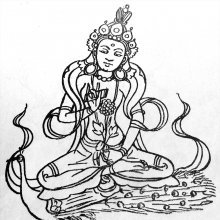
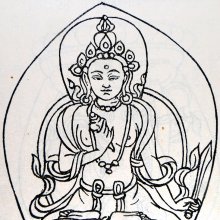
.jpg)
